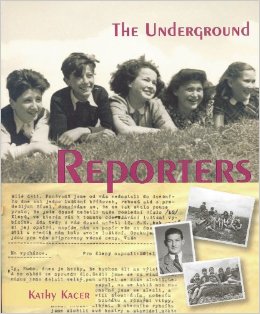
The Underground Reporters
Sunday to Thursday: 09:00-17:00
Fridays and Holiday eves: 09:00-14:00
Yad Vashem is closed on Saturdays and all Jewish Holidays.
Entrance to the Holocaust History Museum is not permitted for children under the age of 10. Babies in strollers or carriers will not be permitted to enter.

The Underground Reporters
The Underground Reporters
Kathy Kacer
Second Story Press, 2004
156 pages
This book presents the true and moving story of a group of young children and adults living under Nazi occupation in Budejovice, Czechoslovakia.
As their freedom becomes increasingly curtailed under the Nazis, they are no longer able to go out to play, swim, go to the cinema, or lead a normal life. Fifteen-year-old Ruda Stadler decides to start a newspaper that would prove that Jewish youth could do more than just play. This would encourage the community to band together and use their imagination.
Using an old typewriter, he wrote the first edition of the newspaper, which was called "Klepy" ("gossip"). The newspaper was circulated to several families and became quite popular. Four additional young people were added to the team of writers, which increased the amount of articles and illustrations. The newspaper became a lifeline for Jewish youth and the entire Jewish community of Budejovice.
Ruda believed that Jews could resist the Nazis through articles and poetry that talked about strength and unity as Jews. In fact, the newspaper also became a form of resistance, and through its articles, the Jewish community retained their freedom.
This is an example of one of Rudy's poems that was printed in the newspaper:
After a Snowstorm in January / Ruda Stadler
Today the Jews went to work,
Looking strained, they cleared the snow...
Some were ashamed to be seen.
Embrace your work,
So that we can show them our strength!
Finally, in April, 1942 the Jews of Budejovice were deported to the ghetto in Theresienstadt. Not knowing if or when he would return, Rudy gave all twenty-two editions of Klepy to a former housekeeper, who kept them throughout WWII.
In 1989, John Freund, the only survivor from the group of young friends, returned to his native village and recovered copies of Klepy from Rudy's sister. They are now on display at the Jewish Museum in Prague. It is through his testimony and that of Frances Neubauer, who also survived, that we know this fascinating story.
The Underground Reporters contains a lot of information from which students and teachers can glean much about Jewish life before the war in Budejovice, and during the Nazi occupation. There are many illustrations from Klepy which can be used in the classroom and many photographs of life in the village before WWII, which can promote and initiate discussion. Cultural resistance and life in Theresienstadt is also addressed.
The book is suitable for junior and high school students.

Thank you for registering to receive information from Yad Vashem.
You will receive periodic updates regarding recent events, publications and new initiatives.

"The work of Yad Vashem is critical and necessary to remind the world of the consequences of hate"
Paul Daly
#GivingTuesday
Donate to Educate Against Hate


Worldwide antisemitism is on the rise.
At Yad Vashem, we strive to make the world a better place by combating antisemitism through teacher training, international lectures and workshops and online courses.
We need you to partner with us in this vital mission to #EducateAgainstHate
The good news:
The Yad Vashem website had recently undergone a major upgrade!
The less good news:
The page you are looking for has apparently been moved.
We are therefore redirecting you to what we hope will be a useful landing page.
For any questions/clarifications/problems, please contact: webmaster@yadvashem.org.il
Press the X button to continue



